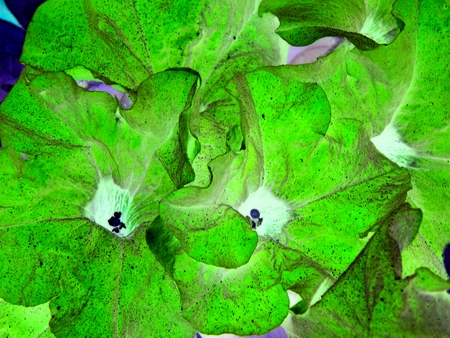1. Understanding the Cabbage White Caterpillar
The Cabbage White butterfly, known scientifically as Pieris rapae and Pieris brassicae, is a familiar sight in British gardens, particularly during the warmer months. These butterflies are instantly recognisable by their pale white wings with distinct black markings. However, it’s their caterpillars that pose a real threat to brassicas such as cabbage, broccoli, kale, and Brussels sprouts—vegetables commonly grown on allotments and in home gardens across the UK.
The caterpillars of both Large White (Pieris brassicae) and Small White (Pieris rapae) butterflies are easy to identify once you know what to look for. The Large White’s larvae are yellowish-green with black spots and fine hairs, while the Small White’s are a smoother, light green shade. Both types can be found on the undersides of leaves, where they feed voraciously, often in groups.
Left unchecked, these caterpillars can rapidly decimate brassica crops by chewing irregular holes through leaves, leaving behind ragged foliage and frass (caterpillar droppings). This not only weakens the plants but also reduces yield and makes vegetables less appealing for the table. Understanding the lifecycle and habits of the Cabbage White caterpillar is the first step towards effective control and protecting your brassicas throughout the growing season.
2. Telltale Signs of Infestation
Spotting cabbage white caterpillars early is crucial to protecting your brassicas, especially given the UK’s cool, damp climate which often favours their proliferation. The most obvious sign is the presence of small green caterpillars on the undersides of leaves, but there are several other symptoms specific to British-grown brassica varieties such as kale, cabbage, broccoli, and Brussels sprouts.
Visual Cues to Watch For
| Symptom | Description | Common Brassicas Affected (UK) |
|---|---|---|
| Holes in Leaves | Irregular, ragged holes ranging from pinpricks to large gaps, particularly towards the centre of young leaves. | Cabbage, Broccoli, Kale |
| Caterpillar Droppings (Frass) | Tiny dark green or black pellets found on leaves or around the base of plants. | Brussels Sprouts, Cauliflower |
| Silky Webbing | Fine threads sometimes visible on the leaf surface or between stems, indicating a recent hatch. | Kohlrabi, Spring Greens |
| Leaf Discolouration | Pale patches or yellowing where larvae have grazed on the leaf surface. | Cabbage, Savoy Cabbage |
| Clusters of Eggs | Small yellow or white oval eggs laid in clusters on the underside of leaves. | Kale, Broccoli, Cabbage |
Distinguishing Cabbage White Damage from Other Pests
It’s important not to confuse cabbage white caterpillar damage with that caused by slugs or flea beetles. Caterpillar holes tend to be larger and more irregular, and their droppings are a reliable indicator. Regular inspection—especially during warm spells in late spring and summer—will help you catch infestations before they spiral out of control.

3. DIY Natural Sprays: Simple Recipes
When it comes to protecting your brassicas from cabbage white caterpillars, homemade sprays offer an effective and eco-friendly alternative to shop-bought pesticides. With a few simple ingredients commonly found in UK kitchens or allotments, you can whip up solutions that deter pests without harming beneficial insects or the environment. Here’s a step-by-step guide for making two popular sprays: garlic spray and soapy water spray.
Garlic Spray
What You’ll Need:
- 1 large bulb of garlic
- 1 litre of water
- 1 teaspoon of washing-up liquid (eco-friendly preferred)
- Saucepan and sieve
- Spray bottle
Steps:
- Peel and crush the garlic cloves.
- Add the garlic to 1 litre of water in a saucepan. Bring to a gentle boil for about 10 minutes.
- Allow the mixture to cool, then strain out the solids using a sieve.
- Add a teaspoon of washing-up liquid to help the spray stick to leaves.
- Pour into a clean spray bottle and use immediately on your brassica plants, focusing on the undersides of leaves where caterpillars often hide.
Tip:
This spray is best applied in the evening or early morning to avoid leaf scorch on sunny days. Reapply after heavy rain.
Soapy Water Spray
What You’ll Need:
- 1 tablespoon of mild washing-up liquid (unscented and eco-friendly)
- 1 litre of lukewarm water
- Spray bottle
Steps:
- Mix the washing-up liquid thoroughly with the water.
- Pour into a spray bottle.
- Mist your brassica plants lightly, ensuring coverage of both upper and lower leaf surfaces.
Caution:
Avoid spraying during hot, sunny weather as this can damage leaves. Test on a small area first if you’re unsure how your particular brassica variety will react.
By utilising these simple recipes, you can manage cabbage white caterpillars effectively while keeping your gardening practices sustainable and safe for local wildlife. Regular monitoring and timely application are key to success with DIY sprays in UK gardens and allotments.
4. Physical Barriers and Companion Planting
One of the most reliable ways to protect brassicas from cabbage white caterpillars in the UK is the use of physical barriers and companion planting. These methods are not only chemical-free but also align with traditional British gardening practices, offering practical solutions that suit the variable British climate.
Physical Barriers: Netting and Fleece
Covering crops with fine mesh netting or horticultural fleece is a tried-and-true method for keeping cabbage white butterflies at bay. The key is to select a mesh size small enough (typically under 7mm) to prevent butterflies from laying eggs on your plants, while still allowing air and rain to reach the crop. Secure all edges of the netting firmly to prevent gaps, as even small openings can allow butterflies access. During periods of heavy rain or strong winds—a common feature of British summers—ensure that your netting is well anchored so it doesn’t blow away or collapse onto the plants.
| Barrier Type | Advantages | Considerations |
|---|---|---|
| Fine Mesh Netting | Excellent pest exclusion; reusable; allows light and water penetration | Needs secure fixing; may require support structure |
| Horticultural Fleece | Provides frost protection as well as pest control | Can increase humidity under cover; best for cooler months |
Companion Planting: Traditional British Allies
Companion planting uses the natural properties of certain plants to deter pests. In UK gardens, planting strong-scented herbs such as sage, thyme, or rosemary near brassicas can help mask their scent and confuse cabbage whites. Nasturtiums are another popular choice—they attract butterflies away from your main crop, acting as a sacrificial plant. Marigolds also serve double duty by attracting beneficial insects like hoverflies, which prey on aphids and other pests.
Suggested Companion Plants for Brassicas
| Companion Plant | Main Benefit | Cultural Note |
|---|---|---|
| Nasturtium | Lures caterpillars away from brassicas | A favourite in cottage gardens across Britain |
| Sage/Thyme/Rosemary | Masks scent of brassicas; deters adult butterflies | Tolerates UK weather; classic kitchen garden herbs |
| Marigold (Calendula) | Attracts beneficial insects for pest control | Easily grown annual in British beds and borders |
Tips Suited to British Weather and Traditions:
- Regularly check and adjust barriers after heavy rain or wind.
- Rotate companion planting combinations each year for best results.
- Harvest sacrificial nasturtiums before they go to seed to prevent self-seeding everywhere.
- If using fleece, remove during hot spells to prevent overheating.
- Work with your garden’s microclimate—south-facing plots may need more shading under netting.
5. Routine Inspection and Maintenance
Keeping cabbage white caterpillars at bay in your brassica patch is not a one-off task; it requires vigilance throughout the growing season. The most effective approach combines regular inspections, timely hand-picking, and a few good habits to ensure your cabbages, kales, and sprouts remain healthy and productive.
Best Practices for Regular Monitoring
Make a habit of inspecting your brassicas at least twice a week, especially during warm spells when caterpillar activity peaks. Early mornings or late afternoons are ideal for spotting pests while they are less active. Pay close attention to the undersides of leaves, where eggs and newly hatched caterpillars like to hide. A magnifying glass can be handy for identifying tiny yellow eggs before they hatch into voracious larvae.
Hand-Picking: Simple but Effective
If you spot any eggs or caterpillars, remove them by hand straight away. Drop them into a bucket of soapy water to ensure they don’t return. This method is surprisingly effective in a typical UK allotment or back garden setting, where chemical controls may not be desirable or necessary. Encourage children to help—many find the process fascinating and it’s an excellent way to teach them about garden ecology.
Maintaining a Healthy Brassica Bed
Healthy plants are naturally more resilient to pest attacks. Ensure your brassicas are well-watered, particularly during dry periods, as stressed plants are more vulnerable. Mulch with organic matter like composted manure or leaf mould to retain moisture and enrich the soil. Rotate crops each year to reduce the risk of recurring pest problems and replenish nutrients. Finally, keep your beds tidy—remove old leaves and debris promptly, as these can harbour pests and disease.
By making inspection and maintenance part of your gardening routine, you’ll give your brassicas the best chance to thrive while keeping cabbage white caterpillars firmly under control.
6. When to Seek Further Help
Even with diligent monitoring and home remedies, cabbage white caterpillars can sometimes get the upper hand on your brassicas. If you notice that your DIY sprays and protective measures aren’t making much of a dent, or if the caterpillar population seems to rebound quickly after treatment, it might be time to look for some backup. In these instances, reaching out to your local garden centre is an excellent next step. Staff there are often familiar with the specific challenges faced in your area and can recommend specialist products or biological controls not readily available at mainstream retailers.
If you’re part of a community gardening group or allotment society, don’t hesitate to tap into their collective experience. Fellow growers are a goldmine of practical advice—perhaps someone has successfully trialled a new netting technique or discovered a less common organic spray that’s worked wonders for their patch. Community discussions can also provide support and camaraderie when pest problems start to feel overwhelming.
For particularly persistent infestations, consider seeking guidance from organisations such as the Royal Horticultural Society (RHS) or your county’s Master Gardener programme. They may offer more advanced solutions like introducing natural predators or using pheromone traps, as well as tailored advice suited to UK climates and garden conditions.
Ultimately, while many cabbage white caterpillar issues can be handled with resourcefulness and persistence, knowing when to seek further help ensures your brassicas have the best chance of thriving. Don’t see asking for help as a failure—it’s simply another tool in your gardening kit, and part of building stronger, more resilient growing spaces for everyone.


